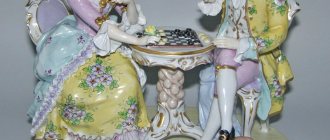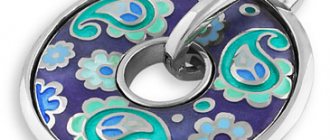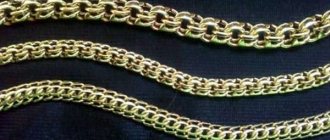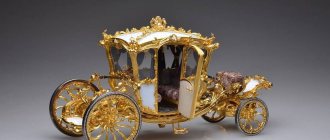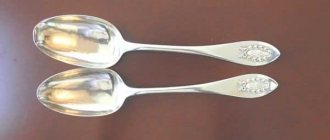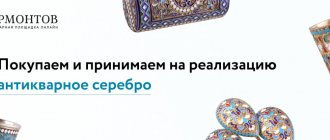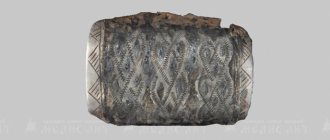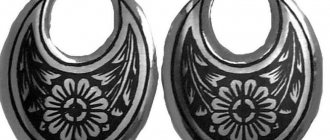The art of enamel of the late 19th - early 20th centuries
The art of enamel has been known in Rus' since the 11th century. In ancient times, enamel was called enamel. The word came from Byzantium along with providence. “Fingitis” in Greek is a light, shiny stone. Enamel comes from the French term email. For centuries, Russian enamellers have created outstanding works of art. The Armory Chamber of the Moscow Kremlin houses a worthy collection of works by Russian enamellers.
The creamer and sugar bowl are kept in the Moscow Kremlin museums. Enamel art
Many museums are proud of their collection of masterpieces of Russian enamel. The year 2021 in the Kremlin began with the exhibition “Carl Faberge and Fyodor Rückert”. It showed amazing objects made using the enamel technique. In a short review we will show you the best items seen at the exhibition. And let’s talk a little about the outstanding enamel master Fedor Rückert.
Table of contents
Fedor Rückert
Historians had to make a lot of effort to learn more about the life of Fyodor Ivanovich Rückert. There is little information about him and they literally collected it bit by bit. Even the mention of Fyodor Rückert in the directory “All Moscow” for 1900 was useful. The Prussian subject was called “the owner of a picturesque silver establishment.”
LADLE. Moscow, 1908-1914. Master F. Rückert. Silver, Cabochons, amalgam, filigree enamel. Collection of D. Yakobashvili, Moscow.
F. Rückert was born, apparently, in 1851. He came to Russia as a teenager. He settled in the German settlement at the Rogozhskaya outpost. History is silent about where and from whom he studied enamel work. It is known that in the 1890s, Rückert collaborated with the jewelry company of Pavel Akimovich Ovchinnikov, a supplier to the imperial court. Even despite the rich capabilities of his company, Ovchinnikov preferred to order products from the small workshop of F. Rückert. This indicates recognition of his virtuoso skill and original style. Fyodor Rückert collaborated with the son of the founder of the jewelry factory, Alexander Petrovich Ovchinnikov.
On the left is a BUCKET. Moscow, 1899-1908. Master F. Rückert, P. Ovchinnikov’s company. Silver, filigree enamel. Collection of M. Revyakin, Moscow.
Other Moscow jewelry companies also turned to the famous enamel designer, in particular the company of Ivan Petrovich Khlebnikov and Orest Fedorovich Kurlyukov. But art historians recognize that the transformation of the work of the enameller and his workshop is associated with the beginning of collaboration with Carl Faberge.
LADLE. Moscow, 1914. Master Fedor Rückert. House of C. Faberge. Silver, amalgam, filigree enamel. Collection of M. Revyakin, Moscow
Feodor Rückert and the art of enamel
The founding of the workshop of Fedor Rückert is considered to be 1886. It is known that in 1890 four craftsmen worked there. Rückert was an innovator in the art of enamel. He was one of the first in Moscow to use enamels with colored specks, decorate things with amalgam, and introduce tight gilded filigree balls into the design.
On the right - BONBONIERE, Moscow, 1908-1917. Master F. Rückert, K. Faberge firm. Silver, amalgam, filigree enamel, window enamel. Collection of M. Revyakin, Moscow. On the left is a CANDY BOWL, 1888. Moscow, I. Khlebnikov company. Silver, filigree enamel, window enamel. Museums Moscow. Kremlin.
At the beginning of the twentieth century in 1904, 14 people already worked in Fyodor Ivanovich’s workshop. The workshop occupied the best premises in the house of Sokolov (architect N. Strukov) on the corner of Vorontsovskaya Street and Bezymyanny Lane. The workshop was located on the ground floor, and the family’s living rooms were on the second floor. Rückert was comfortable leading and controlling the creativity of the masters.
The family of Fedor Rückert was large. He raised ten children - three from his first marriage and seven from his second. His sons Pavel and Fedor worked in their father's workshop and briefly studied at the prestigious Imperial Stroganov School.
The First World War put an end to the workshop's activities. After 1915, it is no longer mentioned in the Moscow directory. Fyodor Ivanovich died in Moscow on December 7, 1918. He was buried at the Vvedensky cemetery.
Before looking at the delightful creations of Moscow enamellers, let us briefly explain what enamel technique the jewelers used. And to understand the specific terms of the labels, we attach a short dictionary.
Types of enamel
Enamels come in different types. Champlevé, cloisonné, window, stained glass, Limoges. Champlevé enamels . Indentations were made on the surface of the object and filled with enamel. The deeper the recess, the darker and richer the color. This is the most ancient type of artistic processing.
Filigree enamel is a type of cloisonne enamel . A depression was pressed into the gold or silver surface along the contour of the design. The thinnest gold or silver strips were soldered to the bottom of the recess. Often they were twisted together to create an elegant braid. Such stripes and braids formed partitions along the contour of the pattern. They were filled with multi-colored enamel.
Enamel on filigree.
Window enamel is one of the most labor-intensive enamel application techniques. Through holes were made on the base, similar to windows. These “windows” were filled with enamel. In Russia, this technique was first used in the 19th century at the plant of Pavel Akimovich Ovchinnikov. The candy dish shown as an example was made by I. Khlebnikov.
Window enamel
Some explanations of the terms
Amalgam is an alloy of mercury with other metals. Amalgam is used for gilding metal products. Below is a dish using amalgam.
Cabochons are polished precious and semi-precious stones processed without faceting. The surface of cabochons is smooth and convex.
Chalcedony is a translucent mineral, a type of quartz. The color can be very different.
Chrysoprase is a semi-precious stone, a variety of quartz and chalcedony. Contains some nickel. The color of the stone is usually apple green, but can vary to dark green and bluish green.
LADLE. 1908-1917. Factory of M. Semyonova. Silver, quartz, chalcedony, chrysoprase, lapis lazuli, filigree enamel. Private collection, Moscow.
Almandine is a variety of garnet, the hardest and most common type of red or red-violet garnet. The color of almandines can be cherry or raspberry.
Bonbonniere is a beautifully decorated box for chocolates.
Cruchon is a cold, refreshing alcoholic drink. It is prepared from a mixture of wines with the addition of fresh and canned fruits. The exhibition displays several devices for the punch.
The art of enamel. Photos of exhibits and videos
Painting on enamel. Enamel art
LADLE. Moscow. 1908-1917. 11th Artel. I.Marshak's company. Silver, chrysoprase, almandine, foil, filigree enamel. Private collection, Moscow.
Wine set (decanter, tray, six shot glasses). Moscow, 1892-1893. G. Kingert's company. Silver, filigree enamel. Museums of the Moscow Kremlin.
Casket. Ovchinnikov Company, Silver, enamel in relief.
Articles about Moscow exhibitions
Whenever possible, we publish reviews and our impressions of Moscow exhibitions, providing them with photographs of exhibits. If you want to look at the royal crowns in detail, we showed them in the review of the “Keepers of Time” exhibition. Exhibits from Thomas Kaplan's Leiden collection were collected in an article about the exhibition. We are very glad that an exhibition dedicated to the collecting activities of the Shchukins was held in Moscow.
In the Moscow Kremlin, the permanent exhibition of the Armory Chamber and the Diamond Fund displays the best works of Russian and European jewelers. We described separately how to get to the Kremlin and which excursion to join .
Catalog
| Cars rarity | Antique weapons | Eastern antique |
| Engravings | home stuff | Painting and graphics |
| Toys and dolls | Interior | Books, periodicals |
| Antique furniture | New Year gifts | Replicas: furniture, interior items |
| Coins, orders | Music | Posters, cards |
| Religion | Light | Silver |
| Glass, crystal | Textile | Equipment and devices |
| Porcelain, ceramics | Watch | Vintage jewelry |
| Securities | Jewelry exclusive | Other |
| Exclusive VIP gifts | Sport | Bells and copper head |
| Autographs and celebrity items |
Dear Sirs!
In 2012, we created for you the online catalog “One Hundred Centuries”. This is much more than an ordinary antique store !
We help meet specialists who sell antiques with lovers of antiques and works of art who want to buy antiques, and we also bring together people who are passionate about collecting.
The main sections of our catalog are Art and Antiques. They contain the best offers from leading antique shops in Moscow and St. Petersburg, as well as antique salons in Russia and the CIS and paintings by contemporary artists.
Now the buyer does not have to waste his time and visit all the antique shops in his city in search of a porcelain figurine or an antique watch. You can buy antiques using our catalog without leaving your home. Call the seller and order the item you like to your home or buy a painting from the artist directly without overpaying to intermediaries! All contacts are next to the lot.
There is also no need to browse through the assortment of all antique online stores, comparing prices on different sites and spending hours trying to choose the best offers.
Our online catalog has everything you need to buy antiques for the most discerning taste. Don’t forget that antiques are not only Moscow; a unique item can be found in any region using the “One Hundred Centuries” website.
Surprise your friends with an exclusive gift that exists in a single copy! And don’t forget that investing in antiques is one of the most profitable! The cost of rarities grows by an average of 20% per year.
We tried to make our catalog convenient and simple for the buyer. To choose for yourself or as a gift something from beautiful antique furniture or antique silver, you can go to the Catalog section and find the desired category or enter the name of the item you are interested in manually in the “catalogue search”, which is located on the main page of the site.
Charity auction. By purchasing or offering for sale works of art and antiques in this section, you are helping children. Our company conducts the auction free of charge, without receiving any commercial benefit. Join us, together we can do more!
If you are lucky enough to become the owner of a rare antique item, or you own an entire collection of antiques, as well as if you are the owner of an antiques gallery in Moscow, St. Petersburg or any other year in Russia and the CIS, we invite you to place your goods in our catalog. We also invite artists interested in publishing and selling paintings to cooperate.
If you are interested in selling antiques or works of art, we invite you to read the terms and conditions in the Seller section.
